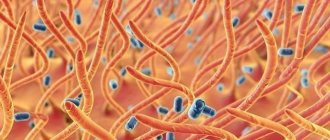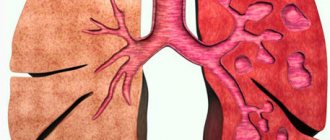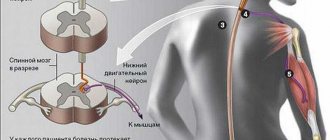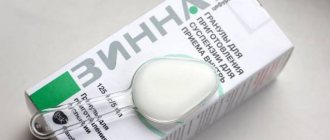- What role does intestinal microflora play for a child’s body?
- Which bacteria are classified as “beneficial”?
- Why dysbiosis occurs: the main causes in children
- How dysbiosis manifests itself in children: clinical symptoms
- Methods for diagnosing dysbiosis in children
- Treatment of dysbiosis in children
- Prognosis and prevention
The term “germs” does not always mean disease and danger, although many people associate it with trouble. Meanwhile, microbes can be pathogenic, which really pose a threat to health, and beneficial, which help create and strengthen the immune system and take an active part in the process of digesting food. Beneficial microbes live in the intestines, their main function is to suppress the growth and vital activity of pathogenic flora - as soon as the balance of beneficial and pathogenic microorganisms is disturbed, the disease dysbiosis occurs. Dysbacteriosis most often occurs in children, since the immune system is not yet fully formed and under the influence of various unfavorable factors, pathogenic microorganisms can defeat beneficial flora.
Intestinal microflora in children
The intestinal microflora consists of various types of microorganisms that live in various parts of the digestive organ. In a normal state, these bacteria do not cause harm to the body and are involved in many metabolic processes. Human waste products are an ideal habitat for them.
Bacteria produce substances necessary to ensure the functioning of the digestive system, natural bowel movements and increase local immunity.
The role of bacteria that make up the intestinal microflora for the child’s body:
- completion of food digestion processes;
- synthesis of nutrients, vitamins and enzymes;
- increasing local and general immunity;
- ensuring the absorption of useful elements in the intestines;
- binding and removing toxins and other harmful substances from the body;
- protecting the body from pathogenic microorganisms;
- ensuring normal contraction of the intestines;
- neutralization of toxic effects on the digestive system;
- stimulating the process of bowel movement.
Functions of microflora
The first function that bacteria perform is to create immunity and maintain it. The normal microflora that determines the human microbiocenosis is most concentrated in the following locations:
- gastrointestinal tract;
- external genitalia;
- leather;
- upper respiratory tract.
The second function is participation in metabolic processes: the breakdown of food using the juices of the stomach and pancreas. If these conditions are disturbed: immunity is reduced, metabolic processes are weakened, then this is followed by the colonization of pathogenic bacteria and the disease develops.
So, for example, if staphylococcus is colonized, diseases associated with staphylococcal flora develop, these are, first of all:
- diseases of the ENT organs: sinusitis, otitis;
- skin lesions: from pustular rashes to furunculosis;
- pyelonephritis;
- colpitis.
Fungi of the genus Candida cause allergic reactions, skin lesions: from dry peeling to atopic dermatitis, psoriasis, eczema, damage to the genital organs: candidiasis (thrush), urethritis, prostatitis.
Causes of dysbiosis in children
The intestines of a newborn baby are sterile. From the first days of a baby’s life, the process of populating its digestive system with microflora begins. The main one in this case is breast milk, which contains lactobacilli, bifidobacteria, vitamins and other useful elements.
It is recommended to put the baby to the breast in the first two hours after birth. If this process is carried out later, the baby may experience disturbances in the microflora. Late breastfeeding may be due to the serious condition of the newborn or his mother.
Factors provoking dysbacteriosis:
artificial feeding (including mixed version);- violation of the diet (including the predominance of sweets in the child’s diet);
- consequences of intestinal infections;
- negative environmental impact;
- diseases of the digestive system;
- giardiasis and other helminthic infestations;
- consequences of long-term or uncontrolled treatment with antibiotics;
- progressive chronic diseases;
- complications after surgery in the digestive system;
- negative consequences of frequent stressful situations and psycho-emotional stress;
- tendency to colds;
- vegetative-vascular dystonia;
- immunodeficiency (congenital or acquired form);
- hormonal changes in the body during puberty;
- tendency to allergic reactions of various etiologies.
Possible complications and consequences
Intestinal flu if not treated correctly leads to many complications:
Dehydration, which can be fatal. To prevent this, you need to start desolating the baby in a timely manner or go to the hospital where a drip will be prescribed. Acetonemic state of the baby. At the same time, ketone bodies accumulate in the patient’s body, which negatively affect the brain. This complication is provoked by a lack of carbohydrates, which are consumed during the disease process. Convulsions can develop due to high temperature. To prevent them, the baby’s body is constantly cooled and rubbed with a salt solution.
Symptoms and signs of intestinal dysbiosis in children
Symptoms of dysbiosis in children differ depending on age. Newborn and infant babies cannot explain deviations in the digestive system.
The development of a pathological process in this case may be indicated by frequent crying of the child, excessive passage of gases, bloating and too frequent bowel movements (up to fifteen times a day, undigested food particles or foam are present in the stool). In older children, symptoms appear with additional manifestations.
The main symptoms of dysbiosis:
- pain in the abdomen (intensifies in the afternoon);
- excessive irritability and sleep disturbance;
- lactose intolerance (comorbidity);
- manifestation of flatulence and rumbling in the stomach;
- alternating diarrhea with constipation;
- pain in the digestive organs after eating food;
- weight gain at a slow pace;
- allergic manifestations (skin reactions);
- green stool with mucus (in newborns);
- bad breath;
- presence of a metallic taste in the mouth;
- tendency to frequent colds.
Which bacteria are classified as “beneficial”?
The intestinal microflora of a healthy child consists of the following bacteria:
- bifidobacteria - about 90%, they are the most important;
- lactobacilli – about 8%, produce lactic acid and help maintain optimal pH levels;
- opportunistic microorganisms - that is, those that are found in the intestines in small quantities and do not threaten health in any way until a certain point. When a child becomes ill, takes antibiotics, is poisoned, or has a digestive disorder, the opportunistic flora is activated, begins to multiply rapidly, and thereby suppresses the number of lacto and bifidobacteria. In this case, all the symptoms of intestinal dysbiosis occur. Conditionally pathogenic flora includes yeast-like fungi, staphylococci, Escherichia coli Klebsiella, and enterobacteria.
From the latter we can judge that dysbiosis in children is not a separate disease, but only a consequence of the pathological processes that have occurred in the body, the occurrence of which is facilitated by many factors and causes.
Analysis for dysbiosis in children
To compile a general clinical picture of the child’s health, additional studies may be prescribed. For example, a coprogram (a procedure for determining the degree of digestion of food), ultrasound of the digestive organs (to identify congenital anomalies and chronic diseases), as well as a bacteriological study of the composition of feces (an analysis to determine the number of different types of bacteria in the intestines).
Rules for conducting analysis for dysbacteriosis:
- feces must be sent for examination within three hours after collection;
- At least one day before the test, you should not give your child antibiotics or other drugs;
- if the child has been prescribed an x-ray examination, then feces obtained after two or three acts of bowel movement are suitable for analysis;
- stool should be collected in a sterile container.
Which doctor should I contact?
If dysbiosis is suspected, you should contact a pediatrician and pediatric gastroenterologist. If there are difficulties in making a diagnosis or it is necessary to determine the presence of chronic diseases in a child, then specialists can prescribe an additional examination from specialized doctors (for example, an immunologist, endocrinologist, etc.).
Differences between bacterial infection and ARVI
Establishing the correct diagnosis is important, because based on the results obtained, the pediatrician selects treatment for the child.
An adult is able to determine the location of pain and inflammation, which will allow the disease to be identified more quickly and the correct medications to be prescribed.
Bacterial infection in children (symptoms will help the doctor establish a diagnosis and select therapy) is treated primarily with antibacterial drugs. Pathogenic microorganisms create a local focus of inflammation. Viruses act on the entire human body, sharply worsening its condition.
To determine the bacterial flora, the pediatrician prescribes a sputum test. To confirm viral infection, a general blood test is performed.
The role of nutrition in the development of dysbiosis in children
Correction of diet is the main method of treating dysbiosis. The diet for infants and older children is different. If the baby cannot eat food on his own and is breastfed, then the woman should change the diet. Potential allergens, harmful foods and foods that negatively affect the digestive processes should be excluded from the menu.
For babies who are bottle-fed, it is recommended to switch to adapted formulas (with special marks on the packaging). Frequent changes of baby food are undesirable. Children who eat their own food are prescribed a special diet.
Role of nutrition:
- poor diet is one of the main causes of dysbiosis;
- Dieting is more effective than drug therapy;
- Errors in the menu can reduce the child’s tendency to recover.
Authorized Products
The recommended menu for intestinal dysbiosis depends on the age of the child. It is necessary to prepare dishes for children using the methods of boiling, steaming or baking. All ingredients must be crushed. If a child has a food allergy, this nuance must be taken into account when preparing the diet. For example, a baby may have an intolerance to dairy products, honey, or an allergy to certain berries and fruits.
Authorized products:
vegetables (potatoes, pumpkin, carrots, zucchini, beets);- cereals (white rice, buckwheat, pearl barley);
- poultry meat (turkey, chicken;
- low-fat fish (hake, cod, perch);
- rabbit meat;
- fermented milk products (kefir, fermented baked milk, cottage cheese);
- sweet varieties of berries (lingonberries, raspberries, blueberries, strawberries);
- butter;
- compotes based on fruits and dried fruits;
- jelly from berries and fruits;
- rosehip decoction.
Products to Avoid
The menu for a child with intestinal dysbiosis should be based on the list of permitted products. Eating certain types of food can reduce the effectiveness of therapy and worsen the condition of the baby's digestive system. Fatty, fried, salty and smoked foods are strictly prohibited. You can't eat fast food. All products from the prohibited list should not be present on the menu, even in minimal quantities.
Prohibited foods: brown rice, millet; raw vegetables; sour varieties of fruit; sweet pastries; confectionery; sausages; whole milk (and cream); lamb and fatty meats; mushrooms; legumes; semi-finished products; waterfowl meat; sauerkraut; turnip; radish; mayonnaise; canned food; carbonated drinks.
What are the risks of microflora disturbance?
With proper care for newborns and proper nutrition for babies and older children, the microbial community is in balance. Parents of infants under 3 months of age often encounter colic, flatulence, and problems with bowel movements. This is explained by the lack of beneficial bacteria and the lack of enzymes for digesting milk.
Unsterile rattles and pacifiers also pose a danger, through which harmful bacteria enter the child’s body and begin to multiply.
Violation of the intestinal microflora in a child is explained by 2 factors: the penetration of pathogenic or a decrease in beneficial microorganisms. The reasons for this are different:
• Incorrect diet for a nursing mother. • Early introduction of artificial complementary foods. • Infections. • Use of certain medications (anti-inflammatory, antibiotics). • Poor environmental conditions. • Some diseases: anemia, rickets. • The child is in a stressful situation.
All this can lead to dysbiosis, that is, an imbalance between pathogenic and beneficial microflora. It can be transient (observed in babies in the first days of life) and true. When breastfeeding, the transient one quickly passes, as lactic acid bacteria displace pathogenic analogues. But it can be delayed in premature babies and those who have been prescribed antibiotics.
True dysbiosis is divided into 2 types. In the compensated form, only stool tests indicate a violation of the microflora. Uncompensated dysbiosis is accompanied by the formation of gases, vomiting, and bloating.
Treatment with drugs
Drug therapy for intestinal dysbiosis is carried out in two directions. First of all, pathogenic microorganisms are destroyed. Antibiotics are used to accomplish this task. Antibacterial agents are prescribed to children only if the disease is infectious. In other cases their use is not required. The second direction of therapy is the colonization of the intestinal microflora with beneficial bacteria (special bacterial preparations).
Bacterial preparations:
with microorganisms that have antagonistic activity (Enterol, Baktisubtil);- with Escherichia coli (Colibacterin);
- with bifidobacteria (Bifiform, Bifindumbacterin);
- with beneficial bacteria (probiotics);
- with lactobacilli and kefir fungus (Acipol);
- with bifidobacteria and B vitamins (Bifi-form);
- with lactobacilli (Biovestin Lacto, Lactobacterin);
- with E. coli, lactobacilli and bifidobacteria (Linex, Bifikol).
For symptomatic treatment of pathology, sorbents and enzymes can be prescribed. Such drugs significantly reduce the manifestation of intoxication, remove toxic compounds from the body and improve the process of digestion of food.
Risks of misdiagnosis
Viral diseases are more common in children than bacterial pathologies. It is important to establish the exact cause of inflammation and select the most effective treatment.
Incorrect diagnosis can lead to serious consequences:
- Against the background of a weak immune system, pathogenic bacteria become more active, which also leads to serious complications. The condition is dangerous for children and pregnant women;
- The bacterial infection has been actively developing for 2 weeks. During this period, the child is a carrier of the disease and is dangerous to others;
- the use of incorrectly selected drugs in a specific situation will lead to the progression of pathological processes and the occurrence of complications (pneumonia, bronchitis).
Bacterial infections in children are more difficult to defeat compared to viruses. Pathogenic microorganisms are able to quickly adapt to the environment and are highly resistant to certain medications.
A pediatrician categorically does not recommend treating a bacterial infection on your own, especially in children and pregnant women. The first symptoms are a reason to go to the hospital.
Folk remedies
There are many recipes for folk remedies for the treatment of dysbiosis, but not all of them are suitable for children. For example, children may categorically refuse to use herbal infusions. For children, you can use special folk remedies with a pleasant taste. Some healthy dishes are recommended to be included in the children's menu to prevent abnormalities in the intestinal microflora and reduce immunity.
Kefir drink with dried fruits:
- Prepare several types of dried fruits (dried apricots, prunes, figs).
- Pour hot water over the preparation (the dried fruits should swell within an hour).
- Grind the dried fruits (you can simply cut them with a knife).
- Pour a tablespoon of the preparation into a glass of kefir and mix the drink thoroughly.
- For younger children, dried fruits can be crushed in a blender.
- It is recommended to drink the drink in the morning.
- The product not only improves the condition of the digestive system, but also improves immunity.
Elderberry and rosehip decoction:
- Combine 100 g of rose hips and elderberries.
- Pour the workpiece with hot water (600 ml).
- Boil the broth for twenty minutes over low heat.
- After filtering and cooling, the drink is ready to drink.
- The product can only be used for children over four years of age.
- The decoction should be consumed in small portions before main meals (three times a day).
Honey-banana paste:
- Mash half a banana with a fork.
- Mix the preparation with a teaspoon of honey.
- It is recommended to use the product for breakfast.
- The child must be excluded from an allergic reaction to honey.
Sweet paste made from seeds, figs and dried apricots:
- Combine pumpkin, sunflower, flax seeds, chopped dried apricots and figs in equal quantities.
- Grind the workpiece in a blender.
- The paste can be eaten with cookies or on its own.
- It is recommended to use this remedy before breakfast and dinner (a teaspoon).
Berry paste:
- Crush lingonberries, raspberries and cranberries (you can chop them in a blender).
- It is allowed to add sugar or honey to the preparation (to improve the taste).
- The product should be consumed after breakfast and dinner (a teaspoon).
Video on the topic: Intestinal dysbiosis, symptoms and treatment in children.
The addition of a bacterial infection to a viral one
According to medical statistics, in 15% of cases in children, a viral infection is complicated by bacterial infection.
Pathological processes are accompanied by the following clinical symptoms:
- reappearance of primary signs of a viral disease;
- body temperature rises;
- symptoms of intoxication occur (weakness, heavy sweating, lethargy).
More often, the addition of a bacterial infection to a viral infection is observed during chickenpox in children. The disease is characterized by rashes on the body and constant itching. It is difficult for a child to understand why they should not be scratched. The baby violates the integrity of the pimple. An infection gets into the wound and pustules form.
Papules rapidly spread throughout the body, causing extensive abscesses. After them, scars remain on the skin. The addition of a bacterial infection can also trigger an inflammatory process in the area of the lymph nodes. The patient in such a situation will require surgical intervention.
Prevention of dysbiosis in children
Some causes of intestinal dysbiosis in children are associated with intrauterine development. The disease can be triggered by infectious diseases of the mother during pregnancy, poor nutrition of the woman and frequent exposure to stressful situations. During the period of gestation, general recommendations should be followed. Elimination of provoking factors will significantly reduce deviations in the state of the microflora of the digestive system in the unborn child.
Measures to prevent dysbacteriosis must be observed at all stages of the baby’s life.
Measures to prevent pathology after the birth of a child:
- compliance with sanitary and hygienic standards;
- balanced diet;
- comprehensive treatment of chronic diseases;
- timely treatment of colds;
- prevention of intestinal infections;
- exclusion of stressful situations;
- adherence to sleep and wakefulness;
- taking antibiotics only as prescribed by a doctor;
- After treatment with antibacterial drugs, probiotics should be taken.
Types of childhood bacterial infections
There are diseases that occur in children, the causative agents of which are pathogenic bacteria:
| Name | Description |
| Intestinal infection (dysentery, typhoid fever, salmonellosis). | The disease is transmitted by the fecal-oral route. Accompanied by nausea, vomiting, abdominal pain and loose stools. In some situations, the body temperature rises and a headache occurs. |
| Bacterial infection of the respiratory organs (sore throat, pneumonia, bronchitis). | An inflammatory process develops in the larynx area. The throat turns red, hurts and the temperature rises. Pathogens are transmitted by aspiration. |
| Bacterial skin infection (furunculosis, erysipelas, impetigo). | Diseases are transmitted by contact. |
| Blood-borne bacterial infections (plague, trench fever, tularemia). | Pathogens enter the human body through transmission. |
The bacterial disease is diphtheria. A characteristic sign is a gray coating on the tonsils. The body temperature also rises and a sore throat appears. It is important to diagnose the disease in a timely manner and begin treatment, since the risk of serious complications is high.
With scarlet fever, small red dots appear on the patient's body. The rash is accompanied by general weakness, fever, pain and irritation in the throat.
Bacterial infection in children (symptoms appear a few days after infection of the body) is divided into the following types:
| Name | Description |
| Pneumococcal (meningitis, pneumonia, otitis media) | More common in children under 2 years of age. Bacteria are found on the mucous membrane. The infection is transmitted by airborne droplets (sneezing, coughing). Microorganisms are protected by a special shell, which does not allow the human body to develop immunity to the disease. They penetrate into the blood and cerebrospinal fluid. The risk category includes young children whose immunity is just developing. The same applies to older people (60 years old). |
| Meningococcal | An infection caused by Neisseria meningitidis. In the early stages of the disease, the patient experiences symptoms that resemble a cold or flu. In 10% of cases, people with meningococcal infection die, 20% are patients who become disabled. Carriers are adults, but children are more often affected. |
In any situation, timely diagnosis and therapy prescribed by a pediatrician are required.
Forecast
Compliance with the diet and all the specialist’s instructions allows you to get rid of dysbacteriosis within one month. The duration of therapy can be increased if the child has complications, congenital pathologies of the digestive system or chronic gastrointestinal diseases. In the absence of adequate treatment and violation of nutritional rules, the prognosis will be unfavorable.
Dysbacteriosis can cause serious abnormalities in the digestive tract, which will reduce the baby’s quality of life.
INTESTINAL DYSBACTERIOSIS
What is meant by dysbiosis? What diagnostic methods are modern and reliable? What medications are used for dysbiosis?
The human intestine contains over 500 different types of microbes, the total number of which reaches 1014, which is an order of magnitude higher than the total number of cellular composition of the human body. The number of microorganisms increases in the distal direction, and in the colon 1 g of feces contains 1011 bacteria, which constitutes 30% of the dry residue of the intestinal contents.
Normal intestinal microbial flora
In the jejunum of healthy people there are up to 105 bacteria per 1 ml of intestinal contents. The bulk of these bacteria are streptococci, staphylococci, lactic acid bacilli, other gram-positive aerobic bacteria and fungi. In the distal ileum, the number of microbes increases to 107–108, primarily due to enterococci, Escherichia coli, bacteroides and anaerobic bacteria. We recently found that the concentration of the parietal microflora of the jejunum is 6 orders of magnitude higher than in its cavity, and amounts to 1011 cells/ml. About 50% of the biomass of the parietal microflora are actinomycetes, approximately 25% are aerobic cocci (staphylococci, streptococci, enterococci and coryneform bacteria), from 20 to 30% are bifidobacteria and lactobacilli.
The number of anaerobes (peptostreptococci, bacteroides, clostridia, propionobacteria) is about 10% in the small intestine and up to 20% in the large intestine. Enterobacteriaceae account for 1% of the total microflora of the mucous membrane.
Up to 90-95% of microbes in the large intestine are anaerobes (bifidobacteria and bacteroides), and only 5-10% of all bacteria are strictly aerobic and facultative flora (lactic acid and E. coli, enterococci, staphylococci, fungi, proteus).
Escherichia coli, enterococci, bifidobacteria and acidophilus bacilli have pronounced antagonistic properties. Under conditions of a normally functioning intestine, they are able to suppress the growth of microorganisms unusual for normal microflora.
The internal surface area of the intestine is about 200 m2. It is reliably protected from the penetration of food antigens, microbes and viruses. The body's immune system plays an important role in organizing this defense. About 85% of human lymphatic tissue is concentrated in the intestinal wall, where secretory IgA is produced. Intestinal microflora stimulates immune defense. Intestinal antigens and toxins from intestinal microbes significantly increase the secretion of IgA into the intestinal lumen.
The breakdown of undigested nutrients in the colon is carried out by bacterial enzymes, resulting in the formation of various amines, phenols, organic acids and other compounds. Toxic products of microbial metabolism (cadaverine, histamine and other amines) are excreted in the urine and normally have no effect on the body. When microbes utilize indigestible carbohydrates (fiber), short-chain fatty acids are formed. They provide intestinal cells with energy carriers and, therefore, improve the trophism of the mucous membrane. Fiber deficiency may impair the permeability of the intestinal barrier due to a deficiency of short-chain fatty acids. As a result, intestinal microbes can enter the bloodstream.
Under the influence of microbial enzymes in the distal ileum, bile acids are deconjugated and primary bile acids are converted into secondary ones. Under physiological conditions, 80 to 95% of bile acids are reabsorbed, the rest are excreted in feces in the form of bacterial metabolites. The latter contribute to the normal formation of feces: they inhibit the absorption of water and thereby prevent excessive dehydration of feces.
Dysbacteriosis
The concept of intestinal dysbiosis includes excessive microbial contamination of the small intestine and changes in the microbial composition of the large intestine. Disruption of microbiocenosis occurs to one degree or another in most patients with pathologies of the intestines and other digestive organs. Therefore, dysbiosis is a bacteriological concept. It can be considered as one of the manifestations or complication of the disease, but not an independent nosological form.
The extreme degree of intestinal dysbiosis is the appearance of gastrointestinal bacteria in the blood (bacteremia) or even the development of sepsis.
The composition of the intestinal microflora is disrupted by diseases of the intestines and other digestive organs, treatment with antibiotics and immunosuppressants, and exposure to harmful environmental factors.
Clinical manifestations of dysbiosis depend on the localization of dysbiotic changes.
Dysbacteriosis of the small intestine
With dysbiosis of the small intestine, the number of some microbes in the mucous membrane of the small intestine is increased, while others are decreased. There is an increase in Eubacterium (30 times), α-streptococci (25 times), enterococci (10 times), Candida (15 times), the appearance of bacteria of the genus Acinetobacter and herpes viruses. The number of most anaerobes, actinomycetes, Klebsiella and other microorganisms that are natural inhabitants of the intestines decreases from 2 to 30 times.
The cause of dysbacteriosis can be: a) excessive entry of microorganisms into the small intestine during achylia and dysfunction of the ileocecal valve; b) favorable conditions for the development of pathological microorganisms in cases of impaired intestinal digestion and absorption, development of immunodeficiency and intestinal obstruction.
Increased proliferation of microbes in the small intestine leads to premature deconjugation of bile acids and their loss in feces. An excess of bile acids increases colon motility and causes diarrhea and steatorrhea, and a deficiency of bile acids leads to impaired absorption of fat-soluble vitamins and the development of cholelithiasis.
Bacterial toxins and metabolites, such as phenols and biogenic amines, can bind vitamin B12.
Some microorganisms have a cytotoxic effect and damage the epithelium of the small intestine. This leads to a decrease in the height of the villi and deepening of the crypts. Electron microscopy reveals degeneration of microvilli, mitochondria and endoplasmic reticulum.
Colon dysbiosis
The composition of the microflora of the colon can change under the influence of various factors and adverse effects that weaken the body’s defense mechanisms (extreme climatic and geographical conditions, pollution of the biosphere with industrial waste and various chemicals, infectious diseases, diseases of the digestive system, malnutrition, ionizing radiation).
Iatrogenic factors play an important role in the development of colon dysbiosis: the use of antibiotics and sulfonamides, immunosuppressants, steroid hormones, radiotherapy, and surgical interventions. Antibacterial drugs significantly suppress not only pathogenic microbial flora, but also the growth of normal microflora in the colon. As a result, microbes that come from outside or endogenous species that are resistant to drugs (staphylococci, Proteus, yeast, enterococci, Pseudomonas aeruginosa) multiply.
Clinical features of dysbiosis
Clinical manifestations of excessive growth of microorganisms in the small intestine may be completely absent, act as one of the pathogenetic factors of chronic recurrent diarrhea, and in some diseases, for example, diverticulosis of the small intestine, partial intestinal obstruction or after surgical operations on the stomach and intestines, lead to severe diarrhea , steatorrhea and B12-deficiency anemia.
The features of the clinical course of the disease in patients with various variants of colon dysbiosis, according to bacteriological analyzes of stool, in most cases cannot be established. It can be noted that patients with chronic intestinal diseases are more often infected with acute intestinal infections compared to healthy people. This is probably due to a decrease in the antagonistic properties of normal intestinal microflora and, above all, the frequent absence of bifidobacteria.
Particularly dangerous is pseudomembranous colitis, which develops in some patients who have been treated with broad-spectrum antibiotics for a long time. This severe variant of dysbiosis is caused by toxins secreted by Pseudomonas aeruginosa Clostridium difficile, which multiplies in the intestines when the normal microbial flora is suppressed.
The main symptom of pseudomembranous colitis is profuse, watery diarrhea, the onset of which was preceded by the prescription of antibiotics. Then cramping pain in the abdomen appears, body temperature rises, and leukocytosis increases in the blood. The endoscopic picture of pseudomembranous colitis is characterized by the presence of plaque-like, ribbon-like and solid “membranes”, soft but tightly fused to the mucous membrane. The changes are most pronounced in the distal parts of the colon and rectum. The mucous membrane is edematous, but not ulcerated. Histological examination reveals subepithelial edema with round cell infiltration of the lamina propria, capillary stasis with the release of red blood cells outside the vessels. At the stage of formation of pseudomembranes under the surface epithelium of the mucous membrane, exudative infiltrates appear. The epithelial layer is raised and absent in places; bare areas of the mucous membrane are covered only by desquamated epithelium. In later stages of the disease, these areas may occupy large segments of the intestine.
Very rarely, a fulminant course of pseudomembranous colitis, reminiscent of cholera, is observed. Dehydration develops within a few hours and ends in death.
Thus, assessment of the clinical significance of dysbiotic changes should be based primarily on clinical manifestations, and not only on the results of a study of fecal microflora.
Diagnostic methods
Diagnosis of dysbiosis is a complex and time-consuming task. To diagnose small intestinal dysbiosis, culture of small intestinal juice obtained using a sterile probe is used. Dysbacteriosis of the colon is detected using bacteriological studies of stool.
Microbial flora produces a large amount of gases, including hydrogen. This phenomenon is used to diagnose dysbiosis. The concentration of hydrogen in exhaled air on an empty stomach is directly dependent on the severity of bacterial contamination of the small intestine. In patients with intestinal diseases occurring with chronic recurrent diarrhea and bacterial contamination of the small intestine, the concentration of hydrogen in exhaled air significantly exceeds 15 ppm.
To diagnose dysbiosis, a lactulose load is also used. Normally, lactulose is not broken down in the small intestine and is metabolized by the microbial flora of the colon. As a result, the amount of hydrogen in the exhaled air increases (Fig. 1).
| Figure 1. Hydrogen concentration in exhaled air |
The most common bacteriological signs of colon dysbiosis are the absence of the main bacterial symbionts - bifidobacteria and a decrease in the number of lactic acid bacilli. The number of E. coli, enterococci, clostridia, staphylococci, yeast-like fungi and Proteus increases. Some bacterial symbionts develop pathological forms. These include hemolyzing flora, E. coli with weakly expressed enzymatic properties, enteropathogenic E. coli, etc.
An in-depth study of microbiocenosis has shown that traditional methods do not provide true information about the state of the intestinal microflora. Of the 500 known species of microbes, only 10-20 microorganisms are usually studied for diagnostic purposes. It is important in which part - in the jejunum, ileum or colon - the microbial composition is studied. Therefore, the prospects for developing clinical problems of dysbiosis are currently associated with the use of chemical methods for differentiating microorganisms, which make it possible to obtain universal information about the state of microbiocenosis. The most widely used for these purposes are gas chromatography (GC) and gas chromatography coupled with mass spectrometry (GC-MS). This method allows one to obtain unique information about the composition of the monomeric chemical components of the microbial cell and metabolites. Markers of this kind can be determined and used to detect microorganisms. The main advantage and fundamental difference of this method from bacteriological ones is the possibility of quantitative determination of more than 170 taxa of clinically significant microorganisms in various environments of the body. In this case, the results of the study can be obtained within a few hours.
Our studies of microbiocenosis in the blood and biopsy samples of the mucous membrane of the small and large intestines in patients with irritable bowel syndrome allowed us to detect deviations from the norm up to a 30-fold increase or decrease in many components.
It is possible to assess changes in intestinal microflora based on blood analysis data using GC-MS microbial markers. Treatment regimen for intestinal dysbiosis
Treatment
Treatment of dysbacteriosis should be comprehensive (scheme) and include the following measures:
- elimination of excessive bacterial contamination of the small intestine;
- restoration of normal microbial flora of the colon;
- improvement of intestinal digestion and absorption;
- restoration of impaired intestinal motility;
- stimulating the body's reactivity.
Antibacterial drugs
Antibacterial drugs are necessary primarily to suppress the excessive growth of microbial flora in the small intestine. The most widely used antibiotics are from the group of tetracyclines, penicillins, cephalosporins, quinolones (tarivid, nitroxoline) and metronidazole.
However, broad-spectrum antibiotics significantly disrupt eubiosis in the colon. Therefore, they should be used only for diseases accompanied by disorders of absorption and intestinal motility, in which, as a rule, there is a pronounced growth of microbial flora in the lumen of the small intestine.
Antibiotics are prescribed orally in normal doses for 7–10 days.
For diseases accompanied by colon dysbiosis, treatment is best carried out with drugs that have a minimal effect on the symbiont microbial flora and suppress the growth of Proteus, staphylococci, yeast fungi and other aggressive strains of microbes. These include antiseptics: intetrix, ersefuril, nitroxoline, furazolidone, etc.
For severe forms of staphylococcal dysbiosis, antibiotics are used: tarivid, palin, metronidazole (Trichopol), as well as biseptol-480, nevigramon.
Antibacterial drugs are prescribed for 10–14 days. If fungi appear in the stool or intestinal juice, the use of nystatin or levorin is indicated.
In all patients with diarrhea associated with antibiotics, occurring with intoxication and leukocytosis, the occurrence of acute diarrhea should be associated with Cl. difficile.
In this case, an urgent stool culture is done for Cl. difficile and prescribe vancomycin 125 mg orally 4 times a day; if necessary, the dose can be increased to 500 mg 4 times a day. Treatment is continued for 7-10 days. Metronidazole at a dose of 500 mg orally 2 times a day, bacitracin 25,000 IU orally 4 times a day are also effective. Bacitracin is almost not absorbed, and therefore a higher concentration of the drug can be created in the colon. In case of dehydration, adequate infusion therapy is used to correct the water and electrolyte balance. To bind the toxin Cl. difficile use cholestyramine (Questran).
Bacterial preparations
Live cultures of normal microbial flora survive in the human intestine from 1 to 10% of the total dose and are capable, to some extent, of performing the physiological function of normal microbial flora. Bacterial drugs can be prescribed without prior antibacterial therapy or after it. Bifidumbacterin, bificol, lactobacterin, bactisubtil, linex, enterol, etc. are used. The course of treatment lasts 1-2 months.
Another possible way to eliminate dysbiosis is to influence the pathogenic microbial flora with metabolic products of normal microorganisms. Such drugs include Hilak Forte. It was created 50 years ago and is still used to treat patients with intestinal pathologies. Hilak forte is a sterile concentrate of metabolic products of normal intestinal microflora: lactic acid, lactose, amino acids and fatty acids. These substances help restore the biological environment in the intestines necessary for the existence of normal microflora and suppress the growth of pathogenic bacteria. Perhaps metabolic products improve the trophism and function of epithelial cells and colonocytes. 1 ml of the drug corresponds to the biosynthetic active substances of 100 billion normal microorganisms. Hilak forte is prescribed 40–60 drops 3 times a day for up to 4 weeks in combination with antibacterial drugs or after their use.
More recently, there have been reports of the possibility of treating acute diarrhea associated with antibiotic therapy and Cl. difficile, large doses of pre- and probiotics.
Regulators of digestion and intestinal motility
In patients with impaired cavity digestion, Creon, pancitrate and other pancreatic enzymes are used. In order to improve the absorption function, Essentiale, Legalon or Karsil are prescribed, since they stabilize the membranes of the intestinal epithelium. Propulsive bowel function is improved by imodium (loperamide) and trimebutine (debridate).
Stimulants of body reactivity
To increase the reactivity of the body in weakened patients, it is advisable to use taktivin, thymalin, thymogen, immunal, immunofan and other immunostimulating agents. The course of treatment should average 4 weeks. Vitamins are prescribed at the same time.
Prevention of dysbacteriosis
Primary prevention of dysbiosis is a very difficult task. Its solution is associated with general preventive problems: improving the environment, rational nutrition, improving well-being and other numerous factors of the external and internal environment.
Secondary prevention involves the rational use of antibiotics and other medications that disrupt eubiosis, timely and optimal treatment of diseases of the digestive system, accompanied by a violation of microbiocenosis.
Medicines
Treatment for intestinal infections is aimed at destroying microbes, removing their toxins from the patient’s body, and eliminating the consequences of the disease. Before the doctor arrives, you need to help cleanse the body. To do this, take the following actions:
- Induce vomiting in a child by giving him a large amount (1.5–2 liters) of water, a weak solution of potassium permanganate or chamomile decoction. After this, the gag reflex is stimulated by pressing two fingers on the root of the tongue. However, these procedures are contraindicated for infants - they may choke on vomit.
- Cleanse the large intestine using an enema. It is filled with boiled water or the above solutions; the temperature of the liquid should not be room temperature, but at 20 degrees. A solution that is too warm, corresponding to the temperature of the human body, on the contrary, will increase blood circulation and the absorption of toxic substances into the blood.
- Vomiting and diarrhea provoke dehydration of the child's body, which can lead to adverse consequences. To prevent dehydration, the child is given plenty of fluids. It is best to use special solutions - Regidron, Orasan, Gastrolit. In this case, the temperature of the drink, on the contrary, should correspond to body temperature.
- Sorbents help speed up the removal of toxins and bacteria from the body. The most common are activated (black) or white carbon, Smecta, Polysorb, Polyphepan and their analogues.
Further actions must be coordinated with your doctor and follow these recommendations. The fact is that the effectiveness of medications will partly depend on the specific causative agent of the disease. Antibiotics, including the most frequently used ones - Levomycetin, Ceftriaxone, Fthalazol, Suprax - are aimed at fighting bacteria; They are useless against viruses and only expose the body to additional stress. The World Health Organization recommends using antibiotics only in cases of:
- prolonged diarrhea (for several days);
- giardiasis;
- severe forms of cholera;
- hemocolitis (presence of blood in the stool).
Antiseptics are used as antibacterial agents - Nifuroxazide, Enterofuril, Furazolidone. They are highly active against most pathogenic and opportunistic pathogens. They are prescribed for a period of 3 to 7 days, depending on the severity of the disease. Antimicrobial drugs are also used - Enterol, Sporobacterin, Baktisubtil, Biosporin. After identifying the pathogen, a bacteriophage is added to the course - an agent that counteracts a specific microorganism.
Modern medicine also offers alternative treatment methods - eubiotics, containing a complex of active microorganisms that counteract infectious agents. In addition, drugs have been developed based on bacteriophages - viruses that can resist one or another type of bacteria. However, the effectiveness of these drugs is still in doubt among most experts, and they cannot be called a panacea. Such drugs are produced, registered and used mainly only in the CIS countries.
In a hospital setting, one of the most important components of therapy is the replenishment of fluid and salt losses in the victim’s body. To do this, he is given infusion drugs, solutions of Begidron, Regidron, Maratonic, Human-Electrolyte are prescribed.
The use of prebiotics for dysbiosis
The modern pharmacological industry is very rich in drugs that help establish the balance of intestinal microflora. These drugs include probiotics and prebiotics, which contain either living microorganisms themselves or their metabolic products.
To stimulate the natural growth of beneficial bacteria, gastroenterologists prescribe prebiotics - these are substances that enter the body along with food of non-microbial origin; they are not digested, but are designed to stimulate the development of normal microflora, since they serve as a nutrient medium for obligate, beneficial flora.
Prebiotics not only help improve the metabolic activity of natural microflora, but also suppress the proliferation of pathogenic bacteria, the body does not reject them. Unlike probiotics, they do not require special storage conditions or special packaging. Prebiotics include:
- Indigestible disaccharides are Lactulose (Normaze, Duphalac, Goodluck, Prelax, Lactusan), Lactitol (Exportal), gastrointestinal transit prebiotic (contains fructooligosaccharides, artichoke, lemon and green tea extracts), lactic acids - Hilak forte.
- These substances are found in natural products: cereals - corn, chicory, onions and garlic, as well as dairy products.
Sexually transmitted infections
A number of sexually transmitted infections (STIs) are caused by bacteria. Some common bacterial STIs include:
- chlamydia
- gonorrhea
- syphilis
Although each STI causes different symptoms, most can cause the following:
- abnormal genital discharge, which may be: foul-smelling
- colorless
- bloody
- unusual consistency
Brain and spinal cord infections
Meningococcal meningitis
is the medical term for a bacterial infection of the lining of the brain and spinal cord. This is a life-threatening condition that requires urgent medical treatment.
Signs and symptoms of meningitis include:
- fever
- headache
- stiff neck
- sensitivity to light
- nausea and vomiting
Some possible symptoms of meningitis in infants:
- inaction or slowness
- vomit
- poor appetite
- protrusion in the soft part of the skull
Preventive measures
Prevention of intestinal infections consists of following 5 rules:
- Compliance with sanitary and hygienic standards and monitoring their compliance by all family members. From an early age, children should be taught to wash their hands after using the toilet and before eating. Parents need to keep the kitchen clean: thoroughly wash food, dishes and all utensils used for their preparation. Control of rodents and insects in residential areas is mandatory.
- Raw ingredients (meat, poultry, fish, shellfish, mushrooms) often become a source of dangerous bacteria. Therefore, they should be separated from prepared dishes - stored in airtight containers, and for cutting, use separate knives and a kitchen board.
- Proper heat treatment of products is important: already at 70 degrees, most pathogenic microorganisms die. Therefore, thoroughly boil and fry meat and fish, determining readiness by the clear color of the juice. When reheating previously prepared liquid foods, it is recommended to bring them to a boil.
- The favorable temperature range for the growth of most bacteria is 5–60 degrees. Therefore, cooked dishes must be placed in the refrigerator within two hours. But even with this storage method, food is suitable for consumption for no more than three days. During the heat, it is not recommended to eat cakes and pastries with a lot of cream - they often become a source of Staphylococcus aureus.
- It is important to carefully monitor the quality of the products consumed. The presence of dents, mold, unpleasant odors and other signs of spoilage makes the inclusion of such a component in a child’s (and adult’s) diet unacceptable. You cannot use products that have expired, no matter what heat treatment you perform. You should only drink bottled or boiled water. Tap water is not intended for drinking; the same applies to water in open reservoirs and swimming pools.
Preventive measures are extremely important when a disease is detected in one of the family members: he should be given separate dishes and isolated from the rest. All other common items must be disinfected.











